Growing basil in a square foot garden is a simple and friendly way to have abundant basil plants. Basil is a popular herb that is easy to grow and harvest. With the use of square foot gardening techniques, you can maximize your space and yield and grow different varieties of basil.
Key Takeaways:
- Square foot gardening is a space-friendly method for growing basil.
- Basil seeds can be started indoors before the last frost.
- Basil plants thrive in sunny spots with moist, well-drained soil.
- Regular harvesting and pruning encourage the plant to produce more leaves and prevent it from flowering.
- Basil grows well with certain companion plants, including tomatoes and bell peppers.
Choosing the Right Type of Basil for Your Square Foot Garden
There are different types of basil to choose from, such as sweet basil, lemon basil, purple basil, and Thai basil. The most common type is sweet basil, which has the traditional flavor that is commonly associated with basil. However, if you want to add a twist to your cooking, you can try growing other flavors of basil.
If you’re looking for a lemony flavor, you can try growing lemon basil. It has a citrus scent and flavor that is perfect for summer dishes or drinks. If you want a less sweet basil, you might consider purple basil. It has a milder taste and adds a beautiful color to your garden. For those looking for a more exotic type of basil, Thai basil is a good option. It has a licorice flavor and is commonly used in Southeast Asian cuisines.
When it comes to planting basil seeds, it’s best to start them indoors about 6 weeks before the last frost. Once the soil is about 70 degrees, you can transplant the plants outside. In a square foot garden, you can plant 4 basil plants in one square foot, or you can dedicate one square per plant. Basil plants need about 6-8 hours of sun a day and prefer moist, well-drained soil. Be sure to keep the basil well watered, especially in the summer, and pick the leaves regularly to keep the plant producing well.
It’s also recommended to pinch off the center shoot of the plant to prevent it from flowering and encourage side growth. Basil plants usually are pest-free, but aphids may occasionally be found on them. When it comes to harvesting basil leaves, you can start doing so when the plant is about 6-8 inches tall. Harvest the leaves by pinching them off the stem, and be sure to keep pinching off the center tips to prevent flowering and encourage leaf production.
Basil can be preserved by cutting the stems and placing them in water like cut flowers, or by drying or freezing the leaves. To dry basil, wash the leaves and place them in a dehydrator or in the oven on the lowest setting until they are dry and crumbly. Basil also has companion plants that it grows well with, such as tomatoes, bell peppers, oregano, cabbage, beans, beets, and potatoes. However, it doesn’t grow well near sage or anise.
Square foot gardening is a great way to grow basil and other plants, especially for those with limited space or time. It eliminates the need for excessive weeding, allows for easy rotation of plants, and provides specific guidelines for planting, making it less intimidating for new gardeners. Overall, choosing the right type of basil for your square foot garden depends on your preferences in flavor and color, and proper care and harvesting techniques will ensure a successful basil harvest.
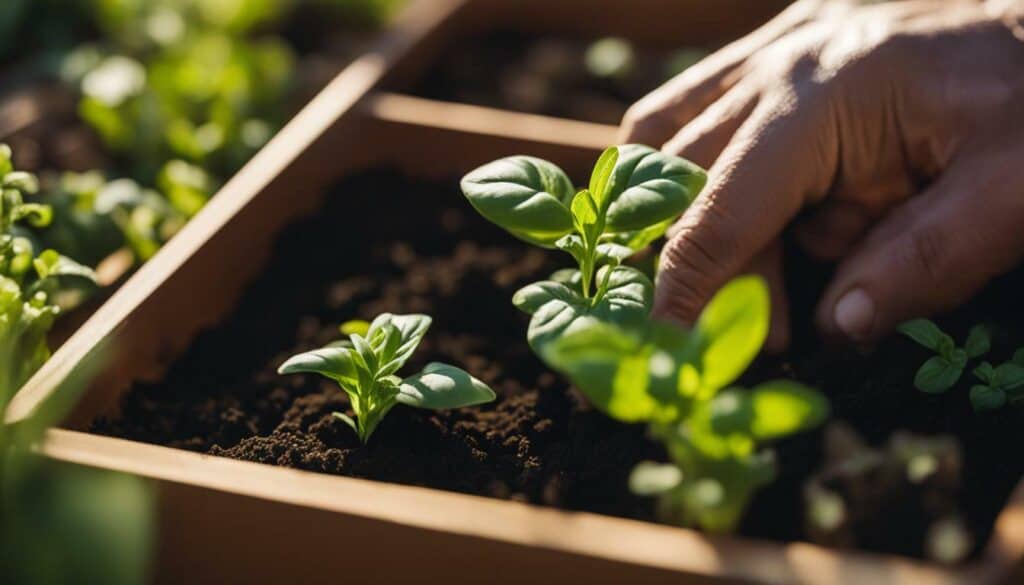
Starting Basil Seeds Indoors
Starting basil seeds indoors before the last frost and transplanting them outside once the soil is about 70 degrees Fahrenheit is recommended. This method gives the seeds a chance to germinate and develop strong roots before they are transplanted outside.
To start basil seeds indoors, use seed starting trays or small containers with drainage holes in the bottom. Fill them with a good quality seed starting mix that is light and fluffy. Moisten the soil before adding two to three seeds per container. Cover the seeds with a thin layer of soil and mist them with water.
| Seed Starting Tips: |
|---|
| – Keep the soil moist but not waterlogged. |
| – Place the containers in a warm, sunny location or use grow lights for 14-16 hours a day. |
| – Once the seedlings emerge, remove the weaker plants and keep the strongest one per container. |
| – Fertilize the seedlings with a weak solution of liquid fertilizer every two weeks. |
After the last frost has passed and the soil has warmed up, the seedlings can be transplanted to the square foot garden. It is important to harden off the seedlings by gradually exposing them to outdoor conditions for a few hours each day, starting with a shady spot and gradually moving to a sunny location over a week.
Basil plants require a sunny spot with 6-8 hours of sunlight per day and moist, well-drained soil. Regular watering, picking the basil leaves regularly to encourage growth, and pinching off center shoots to prevent flowering are necessary for successful basil growth. Basil can be harvested when the plant is 6-8 inches tall by pinching the leaves off the stem.
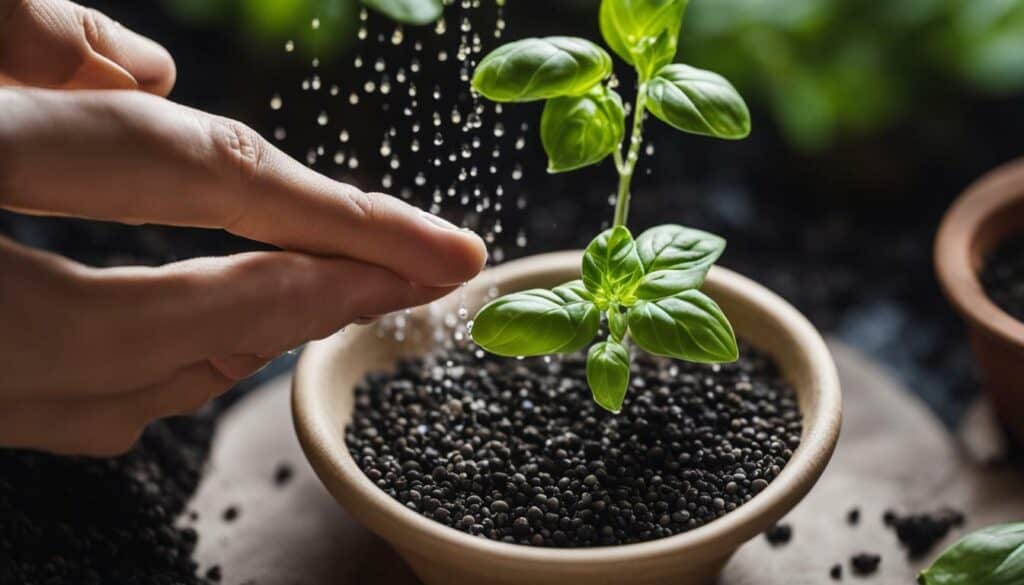
To preserve basil, it can be stored in water like cut flowers, dried, or frozen. Basil grows well with tomatoes, bell peppers, oregano, cabbage, beans, beets, and potatoes, but should be kept away from sage and anise. Square foot gardening is a small space-friendly and low-maintenance method of gardening that can be used for growing basil and other herbs and vegetables. It eliminates the need for extensive weeding and allows for easy rotation and planting. Square foot gardening is also a cost-effective gardening method as it requires fewer seeds and plants.
Growing Basil in a Square Foot Garden
Basil plants should be grown in a sunny spot with well-drained soil, and they need to be watered regularly, about 1 1/2 inches per week. In a square foot garden, planting basil can be maximized by planting at least 4 plants in one square foot.
To ensure a bountiful harvest, basil plants should be regularly pruned to promote side growth and prevent flowering. Harvesting should be done when the plant reaches a height of 6-8 inches by pinching off the leaves from the stem. It is essential to keep picking the leaves to encourage more growth.
Mulching around the basil plants can help retain moisture in the soil and prevent weed growth. It is also important to ensure that the soil is well-drained to avoid waterlogging.
Basil plants are compatible with other plants such as tomatoes, bell peppers, oregano, cabbage, beans, beets, and potatoes. However, it should not be grown near sage or anise. Growing basil near tomatoes is particularly beneficial for both plants.
Preserving basil can be done through different methods such as water propagation, drying, and freezing. Basil can be frozen by washing, drying, and placing the leaves in a freezer bag or chopping them and adding water in an ice cube tray. Dried basil may lose some flavor compared to frozen basil.
Square foot gardening is particularly suitable for growing basil in small spaces. It eliminates the need for extensive weeding and allows for easy crop rotation. Square foot gardening is also cost-effective as it requires fewer seeds and plants compared to traditional row gardens.
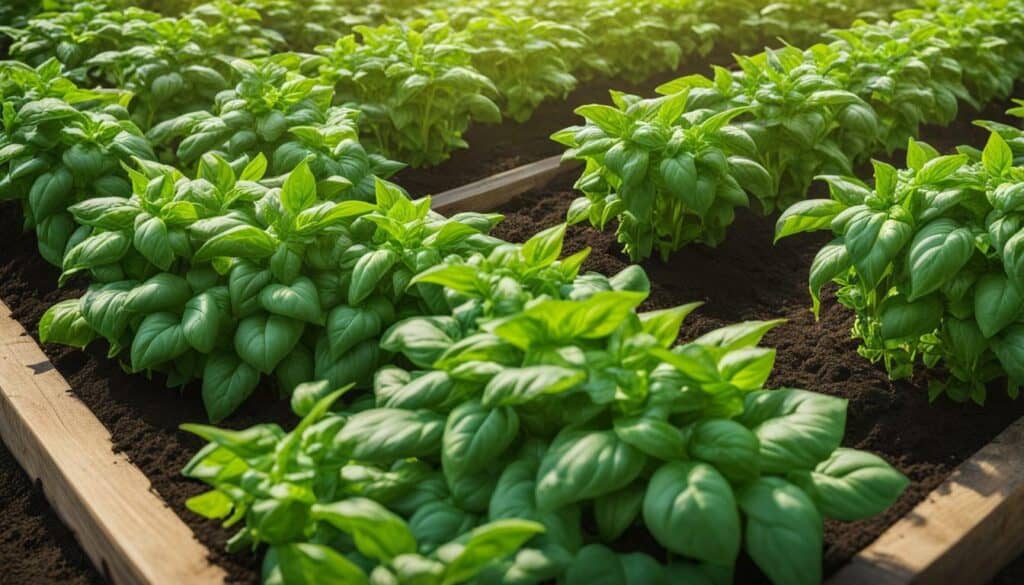
“Growing basil in a square foot garden is a practical and efficient way to enjoy fresh basil for various recipes. Following proper care and maintenance, along with preservation techniques, can ensure a successful basil harvest. Square foot gardening offers many advantages, including minimal weeding, small space-friendly design, easy crop rotation, and cost-effectiveness. It is a great option for both experienced and novice gardeners.
Pruning and Harvesting Basil
Pinching off the center shoot of the basil plant prevents it from flowering and encourages side growth. Regular pruning is important in maintaining a healthy basil plant and ensuring a bountiful harvest in your square foot garden.
Harvesting basil leaves can be done once the plant is 6-8 inches tall by simply pinching the leaves off the stem. It is recommended to harvest basil before the temperature drops to prevent the leaves from turning black.
To preserve basil, it can be stored in water, dried, or frozen. When freezing basil, it is suggested to wash and dry the leaves before placing them in a bag or chopping and placing them in an ice cube tray with water.
Basil is compatible with plants such as tomatoes, bell peppers, oregano, cabbage, beans, beets, and potatoes in a square foot garden.
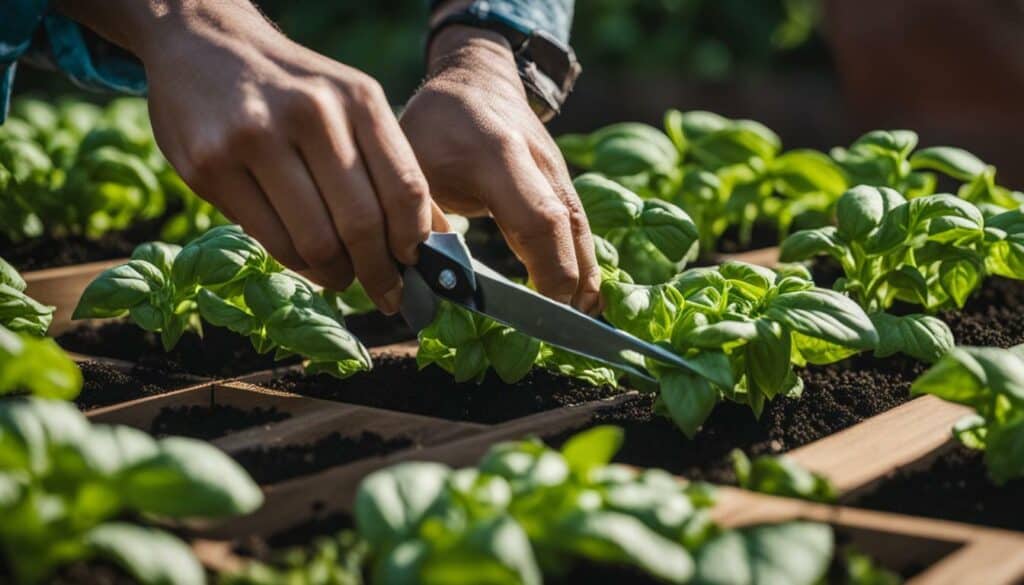
“Basil is a great companion plant. It repels harmful insects and attracts beneficial ones. It also improves the flavor of tomatoes when planted nearby.” – Me
Preserving Basil for Extended Use
Basil can be preserved by cutting stems and placing them in a cup of water, similar to cut flowers. This method is best for short-term fresh usage. However, for long-term storage, there are two preservation methods: drying and freezing.
To dry basil, wash the leaves and place them in a dehydrator or in the oven on the lowest setting until they are dry and crumbly. After drying, store the basil in airtight containers to maintain freshness.
Freezing is another method for preserving basil. Wash and dry the leaves, then place them in a bag or chop them and place them in an ice cube tray with a little water. The frozen basil can be added to sauces and soups when cooking.
It is important to harvest basil before the temperature drops, as cold temperatures can cause the basil to turn black. Preserving basil allows for its use and enjoyment even when it is not in season.

Companion Planting with Basil in a Square Foot Garden
Basil grows well when planted alongside tomatoes, bell peppers, oregano, cabbage, beans, beets, and potatoes, but should be kept away from sage and anise. Companion planting is a gardening technique where crops are planted together to benefit one another. Plants can share nutrients, repel pests, and provide shade or support to each other. When planting basil in a square foot garden, it is important to consider its companions to maximize growth and yield.
Tomatoes and basil are often planted together as they complement each other in flavor and repel harmful insects such as tomato hornworms. Bell peppers are also a good companion to basil as they deter pests and provide shade to the basil plants. Oregano is another herb that grows well with basil as it repels pests and attracts beneficial pollinators.
When planning a square foot garden with basil, it is important to avoid planting it near sage and anise. These plants can stunt the growth of basil and affect its flavor. It is also important to rotate crops each year to prevent soil-borne diseases and to maintain soil fertility.
Companion planting with basil in a square foot garden is a great way to maximize the potential of your garden and create a diverse and balanced ecosystem. By choosing the right companions for your basil plants, you can reap the benefits of a healthy and thriving garden.
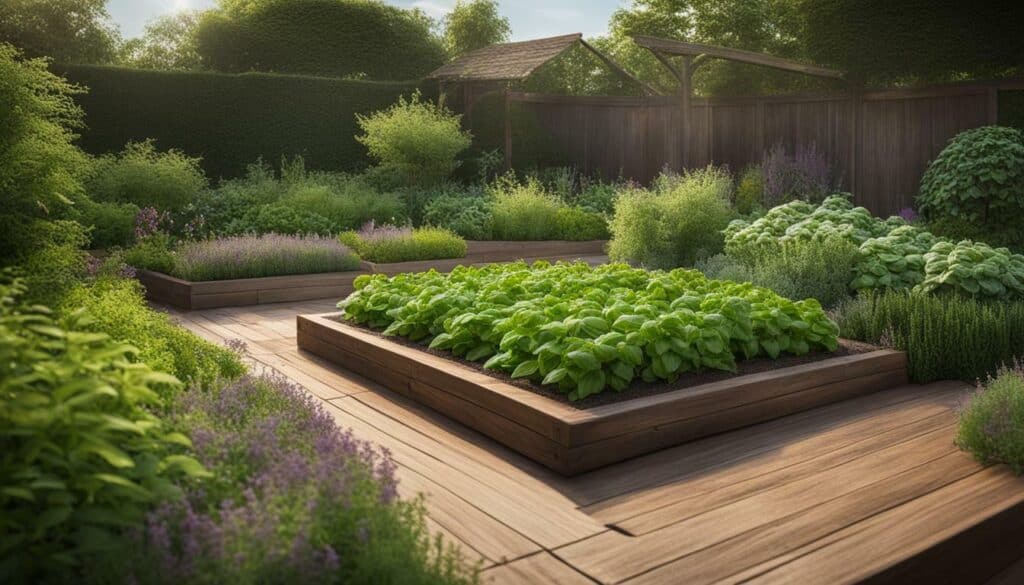
Benefits and Advantages of Square Foot Gardening
Square foot gardening is beneficial for those with limited space and offers minimal weeding, easy rotation, and no guesswork in planting. As I’ve discussed in previous sections, this method of gardening involves creating small, raised beds divided into individual square feet that are each planted with specific crops. Here are some of the benefits and advantages of using this method, especially for growing basil:
- Minimal Weeding: The raised bed structure of square foot gardens helps prevent weed growth, reducing the amount of time and effort needed to maintain the plants. This means you can spend more time enjoying your garden and less time pulling weeds.
- Efficient Use of Space: Square foot gardens make efficient use of small spaces, making them suitable for apartment dwellers or those with limited yard space. They also provide a way to grow a variety of crops in a small area.
- No Guesswork: The method eliminates guesswork by providing specific guidelines on how many seeds or plants to use in each square foot, making it easier to plan and plant your garden. This also means you’ll avoid overcrowding, which can lead to poor growth and yield.
- Easy Rotation: Once plants have finished producing, square foot gardening allows for easy rotation of crops. You can simply replace plants in one square foot with new ones, ensuring a constant supply of fresh produce.
- Suitable for Beginners: Square foot gardening is suitable for beginners, as it offers a low-risk opportunity to try gardening and gain confidence. The method is easy to learn and follows clear, straightforward guidelines.
- Cost-effective: Square foot gardening requires fewer seeds and plants compared to traditional row gardens, making it a more cost-effective option. This means you’ll save money while still enjoying fresh, homegrown produce.
Overall, square foot gardening is a practical and beneficial way to grow a variety of herbs and vegetables, including basil. By following the techniques and tips outlined in this article, you’ll be well on your way to creating a thriving, productive square foot garden.
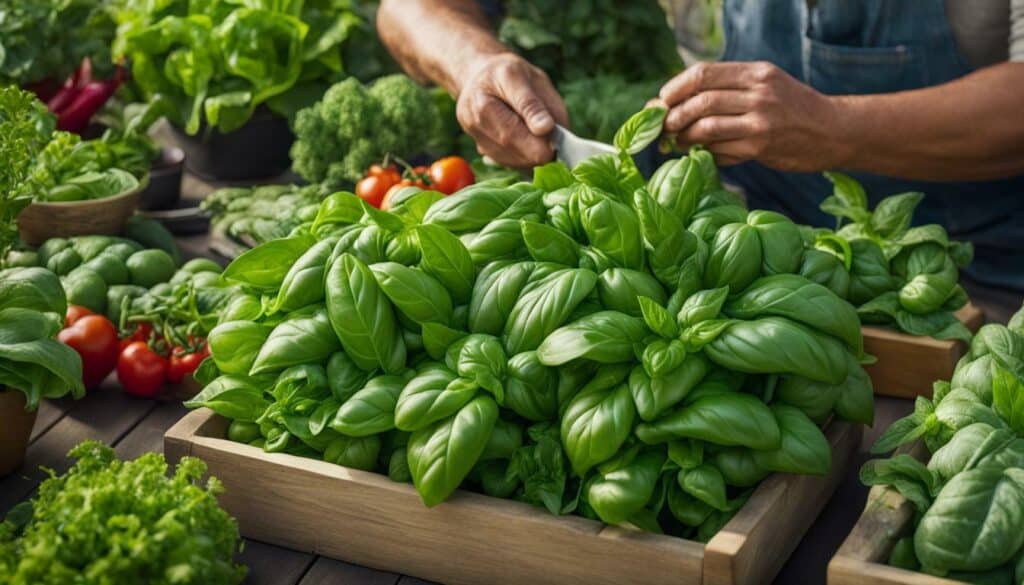
Conclusion
Square foot gardening is a rewarding and efficient way to grow abundant basil in small spaces. With its precise guidelines for planting, minimal weeding, and easy rotation of plants, it is a valuable technique for any home gardener. Not only does it save time and space, but square foot gardening also is a cost-effective option. You will require fewer seeds and plants for a successful harvest.
I hope this guide has provided you with a comprehensive understanding of square foot gardening techniques for basil. By choosing the right type of basil and starting seeds indoors, you will be on your way to a bountiful harvest. Remember to ensure proper growing conditions, pruning, and harvesting techniques, and preserving the basil for extended use. Additionally, companion planting is an excellent way to complement the basil in your square foot garden and increase yields.
Start your green journey today with square foot gardening and watch your basil garden flourish!
FAQ
Q: Can I grow basil in a square foot garden?
A: Yes, growing basil in a square foot garden is a simple and friendly way to have abundant basil plants.
Q: What types of basil can I choose from?
A: You can choose from different types of basil such as sweet basil, lemon basil, purple basil, and Thai basil.
Q: How do I start basil seeds indoors?
A: Start basil seeds indoors before the last frost and transplant them outside once the soil is about 70 degrees Fahrenheit.
Q: What are the ideal growing conditions for basil plants?
A: Basil plants should be grown in a sunny spot with well-drained soil, and they need to be watered regularly, about 1 1/2 inches per week.
Q: How do I prevent basil plants from flowering?
A: Pinching off the center shoot of the basil plant prevents it from flowering and encourages side growth.
Q: When and how do I harvest basil leaves?
A: Harvest basil leaves once the plant is 6-8 inches tall. Harvest before the temperature drops to avoid blackening of the leaves.
Q: How can I preserve basil for extended use?
A: Basil can be preserved by cutting stems and placing them in a cup of water or by drying or freezing them.
Q: Which plants are compatible with basil in a square foot garden?
A: Basil grows well when planted alongside tomatoes, bell peppers, oregano, cabbage, beans, beets, and potatoes.
Q: What are the benefits of square foot gardening for basil?
A: Square foot gardening offers minimal weeding, easy rotation, and no guesswork in planting. It is also more cost-effective compared to traditional row gardens.
What Are Some Recipes for Using Fresh Basil in Tomato Soup?
Fresh basil adds a delightful twist to tomato soup, infusing it with a rich and aromatic flavor. One popular recipe that showcases this delectable combination is the ina garten tomato soup recipe. By following her instructions, you can create a mouthwatering soup that perfectly balances the tanginess of tomatoes with the herbaceous notes of basil.
Source Links
- https://thekitchengarten.com/5-reasons-to-start-square-foot-gardening/
- https://frugalfamilyhome.com/home/gardening/gardening-guide-to-growing-basil
- https://carlsbadcommunitygardens.org/wp-content/uploads/2014/03/Square-Foot-Gardening-Cheat-Sheet.pdf
- https://backyardgardenclub.org/blog/how-to-grow-basil
- https://savvygardening.com/growing-great-basil/
- https://www.mindandsoil.com/pages/how-to-grow-basil-seed-to-harvest-guide
- https://squarefoot.forumotion.com/t6739-genovese-basil
- https://savvygardening.com/how-to-trim-basil/
- https://squarefoot.forumotion.com/t12317-basil-flavor
- https://www.almanac.com/companion-planting-guide-vegetables
- https://plantjudo.com/blog/what-to-plant-together-in-a-square-foot-gardening/
- https://www.littleyellowwheelbarrow.com/square-foot-garden/
- https://gardenerspath.com/how-to/design/guide-to-square-foot-gardening/
- https://bonnieplants.com/blogs/garden-fundamentals/square-foot-gardening
- https://gardeningelsa.com/square-foot-gardening-basil/
- https://thefarmdream.com/2021/01/25/square-foot-gardening-spacing-guide/

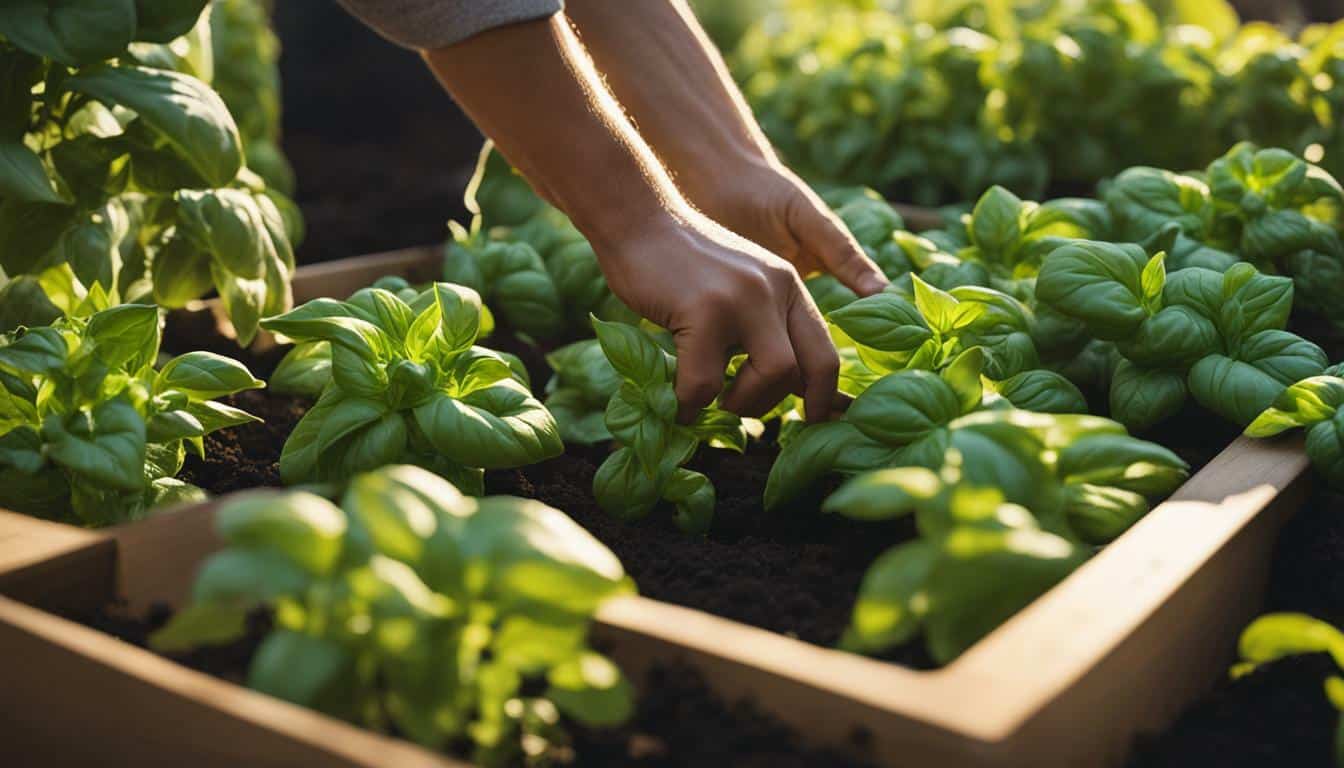



Leave a Reply